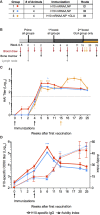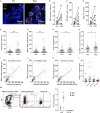Induction of Robust B Cell Responses after Influenza mRNA Vaccination Is Accompanied by Circulating Hemagglutinin-Specific ICOS+ PD-1+ CXCR3+ T Follicular Helper Cells
- PMID: 29181005
- PMCID: PMC5693886
- DOI: 10.3389/fimmu.2017.01539
Induction of Robust B Cell Responses after Influenza mRNA Vaccination Is Accompanied by Circulating Hemagglutinin-Specific ICOS+ PD-1+ CXCR3+ T Follicular Helper Cells
Erratum in
-
Corrigendum: Induction of Robust B Cell Responses After Influenza mRNA Vaccination Is Accompanied by Circulating Hemagglutinin-Specific ICOS+ PD-1+ CXCR3+ T Follicular Helper Cells.Front Immunol. 2019 Apr 2;10:614. doi: 10.3389/fimmu.2019.00614. eCollection 2019. Front Immunol. 2019. PMID: 31001251 Free PMC article.
Abstract
Modified mRNA vaccines have developed into an effective and well-tolerated vaccine platform that offers scalable and precise antigen production. Nevertheless, the immunological events leading to strong antibody responses elicited by mRNA vaccines are largely unknown. In this study, we demonstrate that protective levels of antibodies to hemagglutinin were induced after two immunizations of modified non-replicating mRNA encoding influenza H10 encapsulated in lipid nanoparticles (LNP) in non-human primates. While both intradermal (ID) and intramuscular (IM) administration induced protective titers, ID delivery generated this response more rapidly. Circulating H10-specific memory B cells expanded after each immunization, along with a transient appearance of plasmablasts. The memory B cell pool waned over time but remained detectable throughout the 25-week study. Following prime immunization, H10-specific plasma cells were found in the bone marrow and persisted over time. Germinal centers were formed in vaccine-draining lymph nodes along with an increase in circulating H10-specific ICOS+ PD-1+ CXCR3+ T follicular helper cells, a population shown to correlate with high avidity antibody responses after seasonal influenza vaccination in humans. Collectively, this study demonstrates that mRNA/LNP vaccines potently induce an immunological repertoire associated with the generation of high magnitude and quality antibodies.
Keywords: T follicular helper cells; adaptive immune responses; germinal centers; influenza; mRNA vaccine; non-human primates.
Figures





Similar articles
-
Efficient Targeting and Activation of Antigen-Presenting Cells In Vivo after Modified mRNA Vaccine Administration in Rhesus Macaques.Mol Ther. 2017 Dec 6;25(12):2635-2647. doi: 10.1016/j.ymthe.2017.08.006. Epub 2017 Aug 12. Mol Ther. 2017. PMID: 28958578 Free PMC article.
-
Corrigendum: Induction of Robust B Cell Responses After Influenza mRNA Vaccination Is Accompanied by Circulating Hemagglutinin-Specific ICOS+ PD-1+ CXCR3+ T Follicular Helper Cells.Front Immunol. 2019 Apr 2;10:614. doi: 10.3389/fimmu.2019.00614. eCollection 2019. Front Immunol. 2019. PMID: 31001251 Free PMC article.
-
ICOS(+)PD-1(+)CXCR3(+) T follicular helper cells contribute to the generation of high-avidity antibodies following influenza vaccination.Sci Rep. 2016 May 27;6:26494. doi: 10.1038/srep26494. Sci Rep. 2016. PMID: 27231124 Free PMC article.
-
Codelivery of Envelope Protein in Alum with MVA Vaccine Induces CXCR3-Biased CXCR5+ and CXCR5- CD4 T Cell Responses in Rhesus Macaques.J Immunol. 2015 Aug 1;195(3):994-1005. doi: 10.4049/jimmunol.1500083. Epub 2015 Jun 26. J Immunol. 2015. PMID: 26116502 Free PMC article.
-
CD47 Plays a Role as a Negative Regulator in Inducing Protective Immune Responses to Vaccination against Influenza Virus.J Virol. 2016 Jul 11;90(15):6746-6758. doi: 10.1128/JVI.00605-16. Print 2016 Aug 1. J Virol. 2016. PMID: 27194758 Free PMC article.
Cited by
-
Prediction of lipid nanoparticles for mRNA vaccines by the machine learning algorithm.Acta Pharm Sin B. 2022 Jun;12(6):2950-2962. doi: 10.1016/j.apsb.2021.11.021. Epub 2021 Dec 2. Acta Pharm Sin B. 2022. PMID: 35755271 Free PMC article.
-
Live attenuated pertussis vaccine BPZE1 induces a broad antibody response in humans.J Clin Invest. 2020 May 1;130(5):2332-2346. doi: 10.1172/JCI135020. J Clin Invest. 2020. PMID: 31945015 Free PMC article. Clinical Trial.
-
Immune Assessment of BNT162b2 m-RNA-Spike Based Vaccine Response in Adults.Biomedicines. 2021 Jul 22;9(8):868. doi: 10.3390/biomedicines9080868. Biomedicines. 2021. PMID: 34440072 Free PMC article.
-
Activation and Kinetics of Circulating T Follicular Helper Cells, Specific Plasmablast Response, and Development of Neutralizing Antibodies following Yellow Fever Virus Vaccination.J Immunol. 2021 Aug 15;207(4):1033-1043. doi: 10.4049/jimmunol.2001381. Epub 2021 Jul 28. J Immunol. 2021. PMID: 34321231 Free PMC article.
-
mRNA-Based Vaccines and Mode of Action.Curr Top Microbiol Immunol. 2022;440:1-30. doi: 10.1007/82_2020_230. Curr Top Microbiol Immunol. 2022. PMID: 33591423 Review.
References
LinkOut - more resources
Full Text Sources
Other Literature Sources

